Harry Potter’s Nimbus 2000 may be the most famous witch’s broom in the world, but we gardeners have our own witch’s broom to be concerned about.
A couple of days ago I noticed an unusual growth developing on our asparagus plants. It looked like a tuft of new green ferny leaves growing randomly on the stems. Due to its distinctive shape, I knew immediately that it was Asparagus Witch’s Broom.

Witch’s Broom is a generic term used by plant pathologists to describe growth of this type. It can occure on plants ranging anywhere from potatoes to trees and have many different causes depending on the plant affected.
In the case of Asparagus, the feeding of a small insect called the Asparagus Aphid causes this abnormality. If left unchecked, your Asparagus yields can be dramatically reduced.
Many garden insecticides will kill this pest. Organic gardeners can use rotenone and/or pyrethrum to help control these aphids.
Only the first several plants in one row of our Asparagus show signs of Witch’s Broom so now would be a good time to “nip this problem in the bud” before it gets out of hand.
No playing “Quidditch” with this stuff.
Bob




